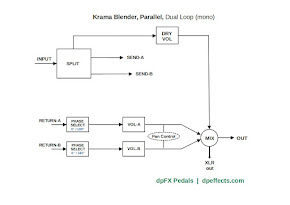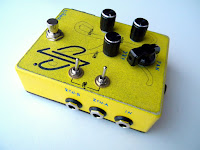Parallel Pedal Blender, capable of handling Line Level signals as well. (24Vpp)
Bassists will be able to use guitar effects without losing low end. Suitable for both bass & guitar.
Specifications in brief:
▹ Two independent, parallel loops A, B (send A/B, return A/B)
▹ PAN between loops (A↔B)
▹ Dry blend
▹ Boost up to +12dB for A, B & Dry
▹ Phase reverse for A & B
▹ Standard TS jacks (6.35mm, 1/4")
▹ Balanced XLR output
▹ Input impedance: 1MΩ (IN, RTN)
▹ Output impedance: 100Ω (OUT, SND)
▹ Output impedance: 100Ω (OUT, SND)
▹ Internal voltage doubler circuit. It make use of the classic 9V supply to produce a dual rail supply ±15V that provides you more than enough headroom.
▹ It can handle higher line level signals, up to ~24Vpp without distorting.
▹ Current draw: 145mA
▹ True Bypass
▹ Enclosure dimensions: 120 x 95 x 35 mm
Below there is a flow-chart that explains the general idea:
Details:
KRAMA gives you the ability to split your signal, route it through two separate loops and blend them all together with your dry signal. The signal volume of the each loop (A,B) and of the dry signal can be controled independently through the pots A,B & DRY which also offer a boost up to +12dB.
NEW FEATURE: PAN function offers you the ability to smoothly PAN from one loop to the other while keeping the dry signal unaffected.
Two phase reverse switches ensure that you will overcome any case of phase cancelation during the blending process when using pedals that reverse the phase. The phase reversal is applied after the signal enters the RETURN jacks.
The pedal is also equipped with balanced XLR output in case you want to route the output e.g. to a console.
KRAMA works with typical 9V power supply (center negative) that should be able to provide at least 150mA. (The pedal itself consumes aprox. 145mA). Internally a separate circuit uses the 9V to produce a dual rail voltage supply ±15V that is necessary for the blender to work properly providing huge amounts of headroom, avoiding crosstalk and ensuring zero signal clipping even in high volumes.
[Do not exceed the recommended 9V supply voltage. It may damage the circuit.]
Use it:
- as parallel LOOP MIXER: Send your signal into two separate loops (A & B), mix them with your dry signal, adjusting mix-levels independently.
- as source BLENDER: Blend the signals of three separate sources by connecting them to 1.IN, 2.RTN-A, 3.RTN-B. Those can be either different instruments, pedal chains or a combination.
- as SPLITTER: Split your signal without 'coloring' or degrading the original signal. (SND-A, SND-B)
The above functions can be combined in many different ways, offering increased functionality and versatility.
IMPORTANT NOTES:
- To avoid hum, ground-loop buzz and other possible noises you should use an isolated power supply and avoid powering KRAMA with the same power cord that other pedals are powered.
- In case you use this pedal to send the output in more than one amps be sure not to create any ground-loops because it will most likely generate noise. If you need isolation check our isolated-output products.
Nomenclature:
KRAMA (Ancient Greek: Κρᾶμα) is the result of mixing two or more metals or other materials producing a somehow homogeneous mixture.









